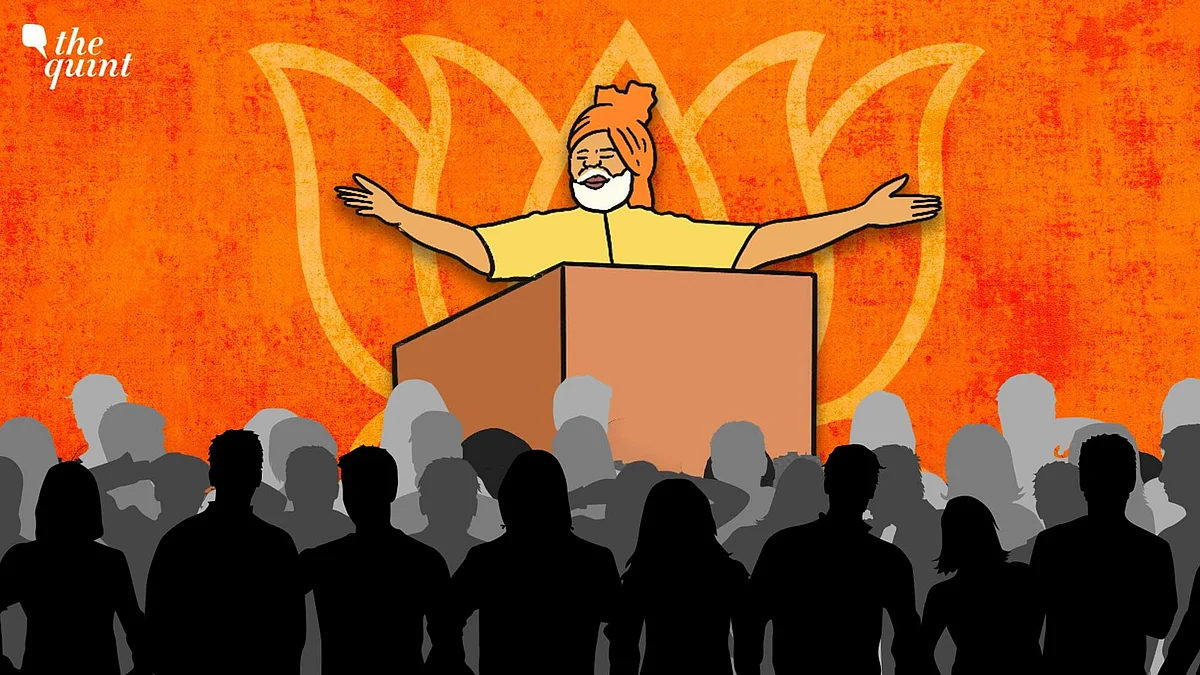
The Modi Years: A Growing Chasm of Liberal Values and Hindutva Politics
Under Narendra Modi, identity assertion has acquired a whole new dimension, write Yashwant Deshmukh and Sutanu Guru.

advertisement
(This is the second in a three-part series of columns that assess and analyse the changes in "mindset" that India has witnessed as a society, polity, and economy since 26 May 2014 when Narendra Modi was sworn in as the Prime Minister of India, a position he held for a third term last year. The authors argue that “mindset” changes, especially when it comes to religious and socio-cultural identity, in India are more profound and will impact the future of Indian politics in more powerful ways than the persona and performance of Modi.)
In the previous column, the authors pointed out an important societal change that is often ignored in daily discourse: when you are free from hunger, your hunger for the other things starts multiplying.
In the eleven years that Narendra Modi has been prime minister, India has decisively moved away from a space where poverty and hunger were the predominant challenges for policy-makers.
Sure, there is still a lot of poverty. But poverty and hunger will never disappear from a country of 1.45 billion citizens.
A Potent New Mix
The authors remarked in the previous column how Nobel Prize-winning author VS Naipaul described this as a “wounded civilisation” trying to reassert itself.
The Supreme Court verdict that led to the construction of a magnificent new Ram Temple at Ayodhya will remain a historic milestone when future historians analyse Modi's tenure.
Proponents of this new blend of nationalism plus Hindutva argue that one key reason India failed to realise even its economic potential compared to Asian peers is the denial and denigration of Hindu heritage, culture and mores. They further argue that the “intellectual” space has been hijacked since 1947 by deracinated 'Brown Sahibs' who look down upon Hinduism. They correlate the relentless economic rise of India in the 21st century with the simultaneous rise of nationalistic Hindutva’s.
Many others don’t agree. They think this phenomenon is an ugly display of anti-Muslim bigotry masquerading as nationalism. They point out toward the 1992 demolition of the Babri Masjid. They remind one of the public lynchings of “cattle thieves” by hate-filled mobs. They point towards the incendiary and provocative slogans raised during processions and Hindu festivals. They are convinced this will damage India irretrievably.
Strange as it may sound, the authors find merit in both arguments. They are upset and repulsed by the kind of anti-Muslim rhetoric that “right-wing” nationalists spew on social media, in public meetings, in songs and even inside Parliament.
India can never become a vibrant and prosperous country and economy on a sustained basis unless the 250 million Indian Muslims become active participants in this journey.
On the other hand, it is also true that the “liberal” class has so blithely misunderstood and misrepresented Hindu traditions and rituals, and so gratuitously brushed away historical injustices under the veneer of electoral secularism, especially across the multiplicity of regions, leaving Hindus as a community increasingly alienated and anxious for appeasement.
Take one example: no one outside Assam had heard of an Assamese general called Lachit Borpukhan who defeated the mighty Mughal army of Aurangzeb. Similarly, barring a handful, no one had heard of Raja Suhel Dev outside the eastern Uttar Prasdesh region. The list is endless.
Beyond Hindu Identity
How does one reconcile the two? There are two incontrovertible facts:
First, India has always been a society steeped in diversity.
Second, India has always been infused with Hindu traditions, philosophy, and culture. A majority of Indians get this. It is only a minority of bigots in all communities and deracinated Indians who don’t. Over the last eleven years, Modi has never shied away from projecting himself as a Hindu nationalist. The consequences have been both positive and negative.
Under Modi, identity assertion has acquired a whole new dimension. We have already talked about the assertion of Hindu identity. Beyond that, there is now a powerful undercurrent of caste, regional and linguistic identity. Like with nationalistic Hindutva, the consequences have been both benign and terrible.
With rising economic security there has come an increased focus on identities. Dalit assertion has been the most consequential one in the last decade or so. This has empowered huge sections of marginalised Indians in a way that was never possible before. But it has also been accompanied by ugly displays of “reverse” bigotry like saying Brahmanism is like leprosy and AIDS. The next census will have an embedded caste census; the first one since 1931.
Rising Linguistic Lines
And then there is linguistic chauvinism. For decades, Bengaluru has been a model of cosmopolitanism. But Karnataka has experienced a resurgence of Kannada pride that goes beyond just pride.
The consequences? The authors know an entrepreneur who runs a restaurant in Bengaluru specialising in Odiya cuisine to cater to a large Odiya flock of IT professionals. He had a signboard with the name in three languages: English, Kannada and Odiya.
Last year, “activists” forced him to remove the Odiya signs. Marathi “activists” now take pride in slapping and roughing up bank managers and other officials who don’t speak Marathi and post such “punishments” on social media.
Has Modi failed to prevent the emergence of this? The authors are not unduly worried. A rapidly changing society with growing prosperity will always throw up such challenges. And India has a history and tradition of eventually sorting out these centrifugal tendencies.
(Yashwant Deshmukh and Sutanu Guru are political analysts with the CVoter Foundation. This is an opinion piece. The views expressed are the authors' own. The Quint neither endorses nor is responsible for them.)
- Access to all paywalled content on site
- Ad-free experience across The Quint
- Early previews of our Special Projects
Published: undefined